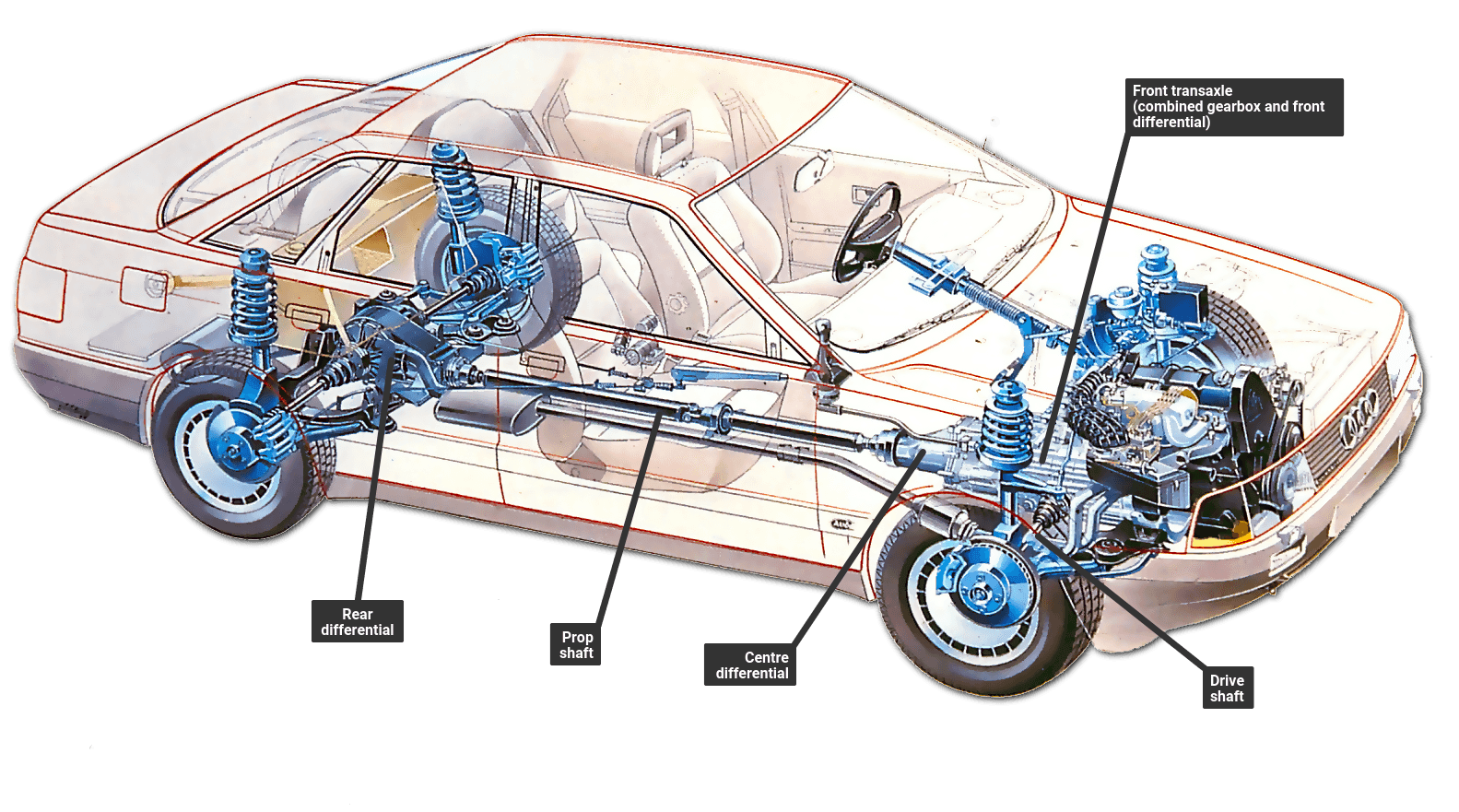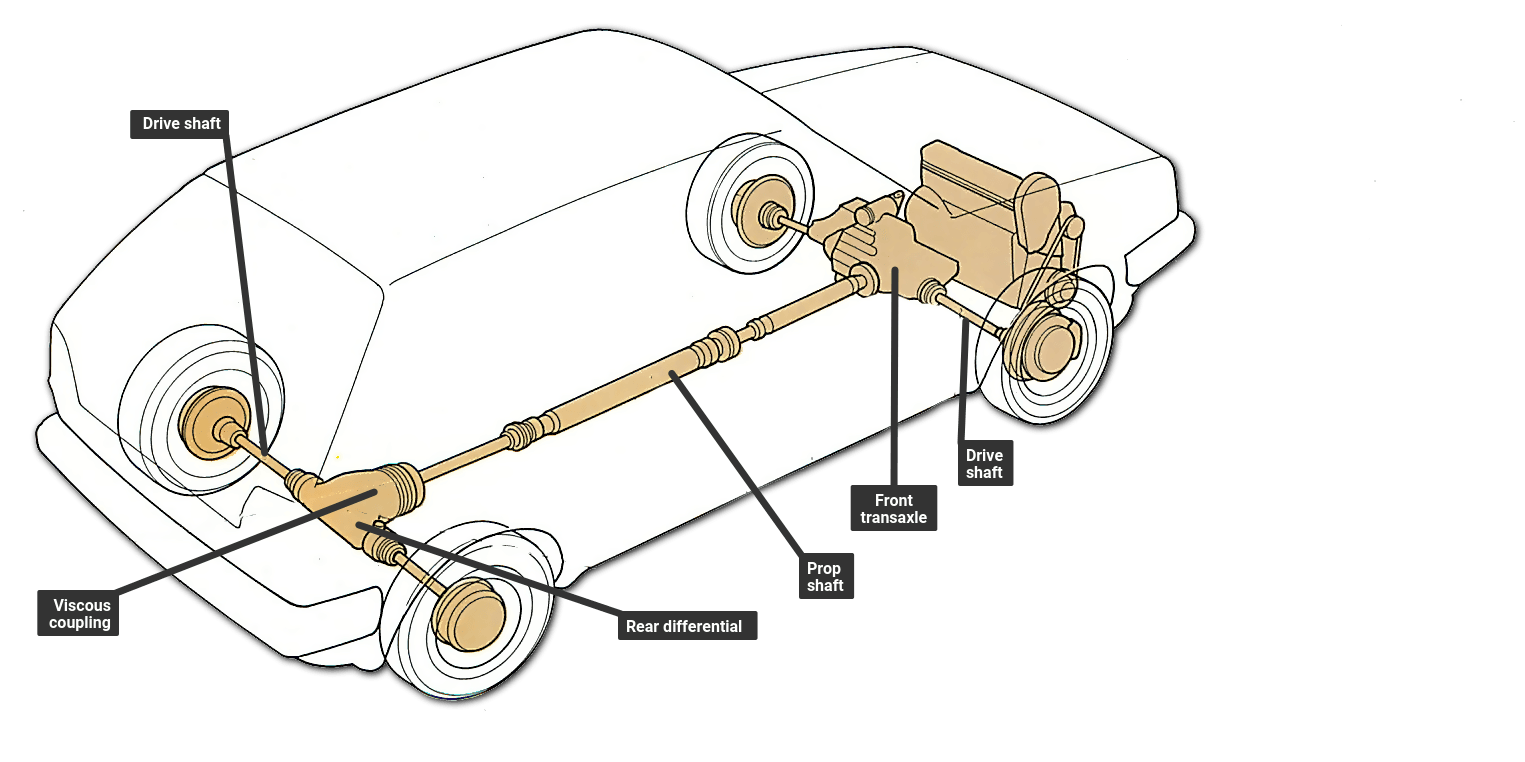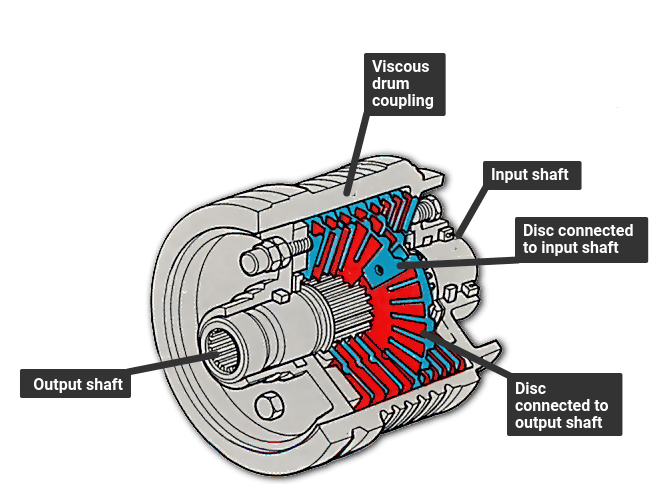Using four-wheel drive
The Video Course teaches you everything about modern cars.
Four-wheel drive has long been fitted to cross-country vehicles, such as Land Rovers, but in the last five years more and more manufacturers are offering it on road cars, where it brings the same advantages of improved road grip.

Two wheels or four
With most two-wheel-drive cars, if one wheel starts spinning, drive will be lost because the differential allows the engine 's power to find the easy way out through the wheel with the least traction .
If all four of the car's wheels can be driven and if the differentials can be locked, the car can keep going even if only one of its wheels is
gripping the surface. This feature is of obvious value to cross-country vehicles, but it also means that a four-wheel-drive road car will be able to keep going on icy or muddy roads.
Permanent 4WD
Some road cars are basically two-wheel drive with a four-wheel-drive option which you engage when the road surface demands it. But others are permanent four-wheel drive.
With permanent four-wheel drive, power is fed through the gearbox to a centre differential, usually mounted just behind the gearbox itself. This differential divides the power between the front and rear
wheels in such a way that it allows the front and rear wheels to rotate at slightly different speeds when necessary, for instance when the car is being manoeuvred at low speeds.
If this didn't happen the slight difference in rotational speed between the front and rear wheels would impose severe strains on the transmission - a condition known as wind-up. The wind-up would only be released if a tyre lost its grip.
From the centre differential, the power goes to the front and rear wheels via a prop shaft and drive shafts - the exact layout depends on whether the car was originally front- or rear-wheel drive.
Two additional differentials are required to make four-wheel drive work properly - one between the front wheels and one between the rear ones. As on an ordinary twowheel-drive car, these differentials allow the wheels on one side to turn
faster than the others, as happens when the car turns a corner.
4WD on the road
Four-wheel drive for road use came into prominence in 1966, when Jensen launched their FF model, which was based on the Interceptor bodyshell.
The FF (standing for Ferguson Formula after the company who designed and developed the system) had permanent four-wheel drive and anti-lock brakes, but the idea did not catch on.
The effectiveness of four-wheel drive for road cars was proved by the Audi Quattro, which was subsequently developed into a successful rally car. Since then, four-wheel drive has appeared as standard equipment or as an optional extra on cars from Ford, Alfa Romeo, Toyota and Fiat, among others.
Diff locks
With permanent four-wheel-drive systems, there needs to be some means of locking the differentials, especially the centre one, or all drive could be lost if one wheel met a patch of ice.
Some systems have a self-energizing locking differential - the Ford Sierra 4x4 has a centre differential which incorporates a viscous fluid. When the difference in speed between the front and rear wheels increases, the fluid resists this tendency and locks up the differential so that power is supplied to both the front and rear wheels.
Audi's forthcoming quattro models will use a Torsen central differential. This device (Torsen is short for torque sensing) uses worm gears to limit the amount by which one of the car's axles can over-run the other.
Most other permanent fourwheel-drive vehicles, including the Range Rover, have a manual differential lock. When the driver engages this, power is directed to both the front and rear wheels, whether or not any wheel is spinning.
Some four-wheel-drive cars have a rear differential lock as well. Engaging both the central lock and the rear lock forces both rear wheels to turn even if one front wheel is slipping.
Part-time 4WD
Some four-wheel-drive cars have 'occasional' four-wheel drive for off-road use and for coping with ice, snow and other slippery surfaces.
These cars have no centre differential, just a transfer box or dog clutch to transmit drive to the other pair of wheels.
If the transfer box were engaged so that four-wheel drive were used for ordinary driving, the absence of a centre differential would soon cause wind-up. This doesn't occur if the system is used correctly because the strain is released every time a wheel loses grip.
Advantages of 4WD
For the driver who wants to cross muddy fields , there is no argument - two-wheel drive just will not do. But even for the ordinary road driver, there are some benefits to be had from four-wheel drive.
When conditions are bad, four-
wheel drive gives more traction Audi have calculated that the quattro system gives more than one and a half times the traction on wet roads and more than twice the traction on ice, compared with two-wheeldrive cars.
Even when the roads are dry, four-wheel drive enables the car to put the power down better. A tyre has only so much grip on the road, so the more grip that is spent in transmitting power, the less it has left to resist sideways cornering forces. Therefore, if the power is shared among the wheels, each one can contribute to both driving and cornering.
Disadvantages
The disadvantages of four-wheel-drive systems spring largely from their complexity. The extra machinery that is needed for a four-wheel-drive system is expensive and heavy. The extra friction in the more complex transmission means a small increase in fuel consumption although tyre wear will probably be more even compared with a twowheel-drive car because all four wheels are sharing the work.
The other problem with four-wheel drive is that, although the system will keep you going in slippery conditions, it cannot stop the car much more quickly. For this reason, it should be used in conjunction with anti-lock braking.
The need for four-wheel drive on the road has only arisen since the development of powerful frontwheel-drive cars, when manufacturers found that the steering imposed a limit on the amount of power that could be put through the front wheels. From that point of view, four-wheel drive is perhaps no more than a fashionable trend for upmarket cars. Whether the trend continues, so that it becomes the norm on ordinary family cars, will be seen in the next few years.
On-demand 4WD with synchro

An alternative form of part-time four-wheel drive, as fitted to the VW Golf synchro, gives all-wheel drive automatically when it is needed. The car's driveline to the front wheels is identical to the normal front-wheel-
drive model, but there is a prop shaft emerging from the rear of the transaxle to drive the rear wheels when required.
In normal use the car has only its front wheels driven, but if the front wheels start losing traction and overrun the rear ones, the viscous coupling at the end of the prop shaft locks up to transmit drive to the rear wheels.
Viscous coupling

An automatic alternative to the locking differential is the viscous coupling.
The coupling consists of a drum which contains a number of slotted discs and some silicone fluid that is resistant to shear — that is, slicing between the discs. Half the discs are connected to one drive shaft and half to the other.
The Ultimate Car Mechanics video course
Learn everything about modern cars from our new video series.
Learn more >-
We build a Mazda MX5 Miata from scratch
We start by tearing down and then rebuilding the whole car.
-
Every part explained
There's ridiculous detail on every part. Clearly and easily explained.
-
All modeled in 3D
We've created the most detailed 3D model ever produced so we can show you everything working.






